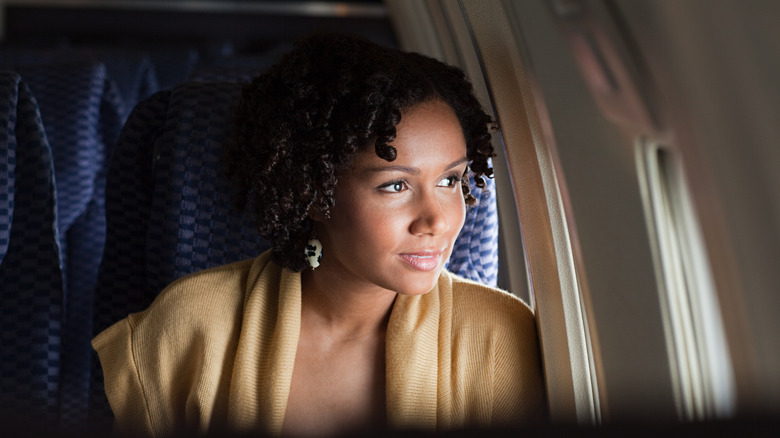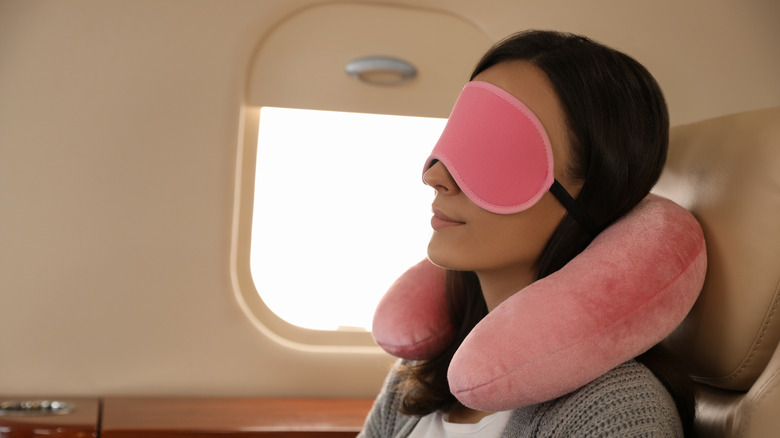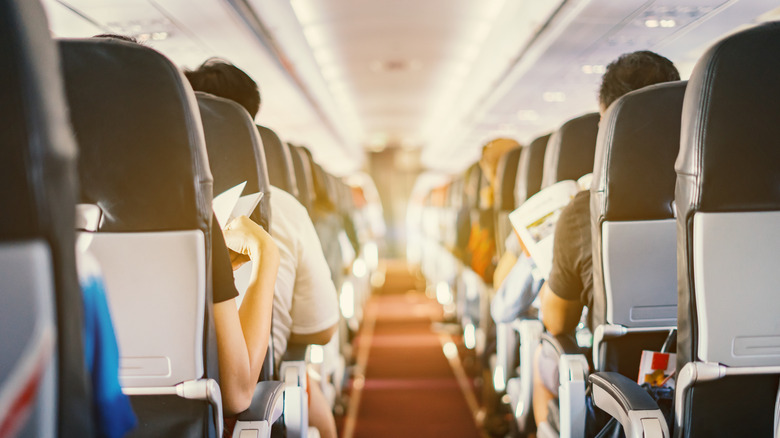The Best Seat Selection For A Red-Eye Flight
Flying is a fast way to travel, but it's not always the most comfortable. The Federal Aviation Administration reports annual earnings from the aviation industry of $488 billion. This profit is the result of flight routes designed with efficiency in mind. Alongside the traditional daytime flights passengers can purchase, red-eye flight options also exist. These routes aren't always appealing but they're sometimes the best solutions to getting where you're going.
Red-eye flights are thought to be named for the groggy-eyed passengers that disembark a plane that has traveled through the night to reach its destination in the morning. Red-eye flights are frequently scheduled to avoid losing daytime hours on long-haul trips. These routes can save passengers time, but they aren't always convenient when it comes to onboard comfort or sleep schedules.
It can be hard for travelers to align their internal clocks to the flight schedule on a red-eye. Resting can be difficult too, especially if you choose a seat that isn't conducive to successful sleep patterns. Fortunately, there are strategies for improved sleep and comfort on a red-eye flight that just might leave you feeling more refreshed upon arrival.
Some strategies are frequently put to good use. Adjusting your schedule before departure and investing in a quality sleep mask are both typical ways travelers can make a red-eye flight more comfortable. Beyond these more common strategies, it's important to remember that seat selection can also make a huge difference in how comfortable your red-eye flight turns out.
Choose a window seat for better sleep
One of the most important factors to consider when choosing a seat on a red-eye flight is how many disruptions you might encounter during your travels. Unlike a daytime flight, a red-eye flight is a nighttime experience. This means you'll likely attempt to spend the majority of it resting for that early morning arrival ahead.
Picking a seat that puts you in the path of a significant amount of passenger and flight attendant foot traffic can be unexpectedly problematic, and can ruin a restful experience before it's even begun. With this in mind, it's generally better to select a window seat over an aisle seat when you have an upcoming red-eye flight on the calendar.
Yes, you're going to have to ask your seat mate to kindly move from time to time when you've selected a window seat and need to use the lavatory. However, a window seat on a red-eye flight minimizes disruption to your rest by eliminating opportunities for other passengers to startle you or bump you as they pass by. A window seat is also an advantage in avoiding that in-flight service cart that can unpleasantly catch your knee or toe while you attempt to sleep in an aisle seat.
Plane positioning makes a difference
A window seat is ideal for a red-eye flight but where you position yourself on the plane makes a difference too. Different areas can directly affect how you feel upon landing. When you're choosing seats, there are some sections you'll want to try to avoid.
Not all planes are designed identically, but many aircraft are produced with exit row seats that have less room to recline in the name of safety standards. This is important in the event of an emergency, but it can be an unpleasant surprise on a red-eye flight where you're hoping to sleep only to find you don't have as much of an option to get comfortable. It's also good to keep in mind that an exit row in the middle of the plane is often situated near the lavatory. It's a noisier area where passengers wait and congregate which can make it difficult to sleep.
The very last row of seats on a plane also has a limited range to recline. In this area, even a window seat can prove uncomfortable during long flights. Ultimately, a window seat as close to the front of the plane as possible will prove to be the least disruptive and most comfortable for resting on a red-eye flight.
Red-eye flight alternatives aren't always readily available to travelers. Taking time to strategically select a seat can help. Consider placement and seat type to give yourself an advantage the next time you fly the red-eye.


